The x86 Power Myth Busted: In-Depth Clover Trail Power Analysis
by Anand Lal Shimpi on December 24, 2012 5:00 PM ESTSunSpider 0.9.1
Now the fun stuff. Doing power profiles of our standard benchmarks gives us good insight into how well each vendor was able to balance peak performance and average power. In general it's ok to burn more power for a short amount of time as long as it means you'll get to sleep quicker. This was one of the fundamentals of the first transition to mobile from the early 2000s.
We already know that Intel completes SunSpider quicker thanks to its improved memory subsystem over the Cortex A9, but it also does so with much better average power (3.70W vs. 4.77W for this chart). A big part of the average power savings comes courtesy of what happens at the very tail end of this graph where the W510 is able to race to sleep quicker, and thus saves a good deal of power.
| JavaScript Performance | |||||||
| Time in ms (Lower is Better) | Kraken | SunSpider | RIA Bench Focus | ||||
| Acer W510 (Atom Z2760 1.8GHz) | 33220.9ms | 730.8ms | 3959ms | ||||
| Microsoft Surface (Tegra 3 1.3GHz) | 49595.5ms | 981.1ms | 5880ms | ||||
| Samsung ATIV Smart PC (Atom Z2760 1.8GHz) | 33406.0ms | 721.3ms | 3752ms | ||||
| Apple iPad 4 (A6X) | 19086.9ms | 834.7ms | - | ||||
| Google Nexus 10 (Exynos 5 Dual) | 11146.0ms | 1384.1ms | - | ||||
I also used SunSpider as an opportunity to validate the results from Intel's tablets with my own review samples. To generate this chart I measured power, every second, at the wall with both devices plugged in and with a fully charged battery. The resulting power consumption numbers include the efficiency loss at the AC adapter but the general curve shoud mimic the results above:
Note that the results do generally line up, although measuring at the battery gives more accurate results for the device and using the NI DAQ I was able to get better granularity on the power measurements.
Looking at CPU level power consumption we see a very even match between Atom and Tegra 3. Intel's advantage really comes from being able to complete the workload quicker (0.52W compared to 0.72W on average).
Once again we see a pretty significant difference in power consumption on the GPU rail between these two platforms.
Kraken
Mozilla's Kraken benchmark is a new addition to our js performance suite, and it's a beast. The test runs for much longer than SunSpider, but largely tells a similar story:
RIABench
RIABench's Focus Tests are on the other end of the spectrum, and take a matter of seconds to complete. What we get in turn is a more granular look at power consumption:




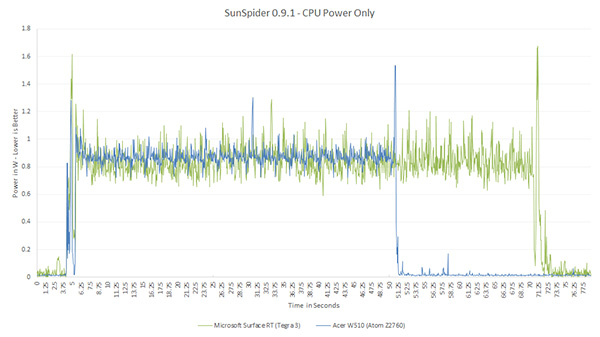

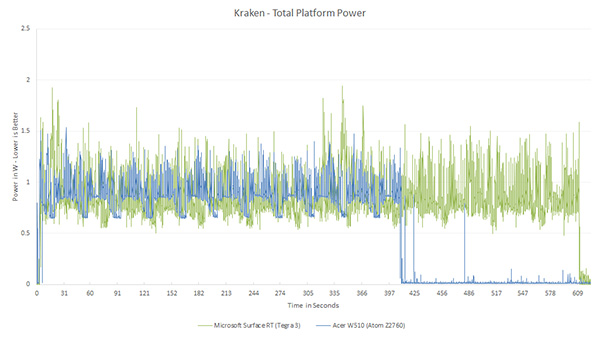
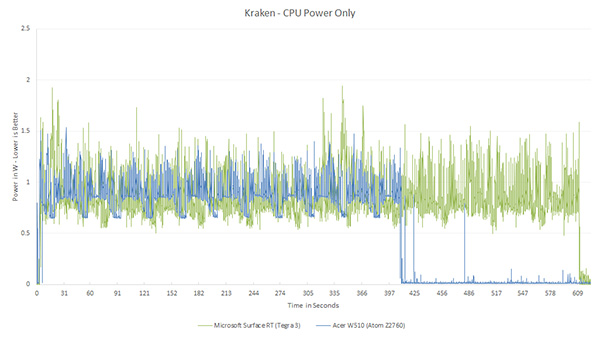

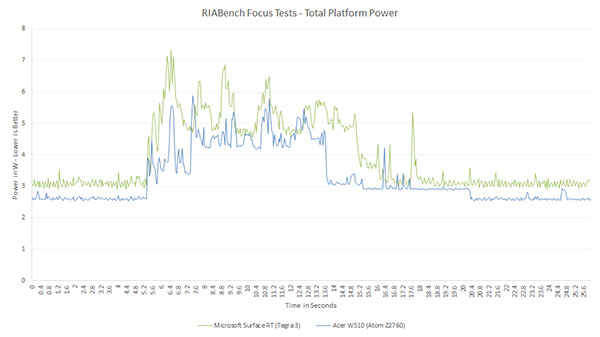
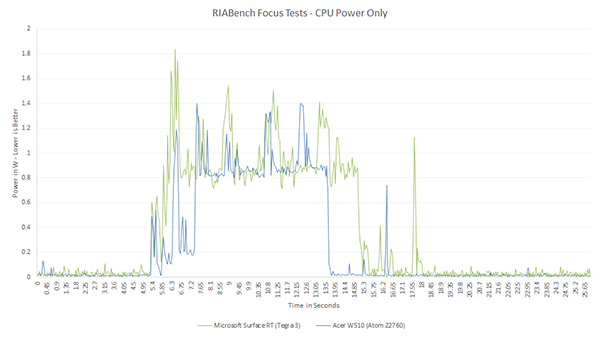
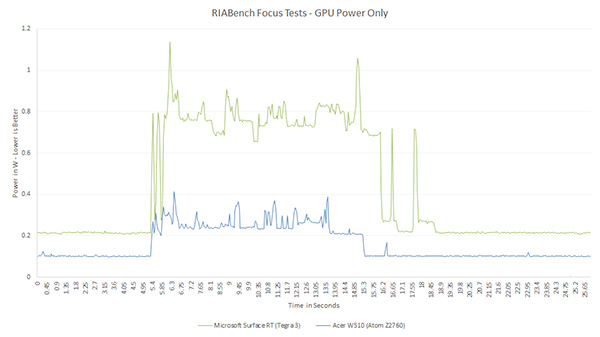








163 Comments
View All Comments
Veteranv2 - Friday, December 28, 2012 - link
You mean on Win8 right?You take a bloated x86 optimized OS with crappy ARM support and you compare it to the best x86 chip maker.
Great... Happy world you live in.
Braumin - Friday, December 28, 2012 - link
Um, smart ass. Medfield was running Android.And Windows 8/RT is far from bloated. Good try though.
jwcalla - Saturday, December 29, 2012 - link
Unfortunately we can't draw too many conclusions about Win8 vs. RT since we can't look at the code base. Especially for benchmarks like "cold boot". The manner of bringing up devices is likely rather distinct.And, unfortunately, we don't know anything about the compilers used for the software either.
Now a compiler like GCC can give us some broad ideas... we can test and see that, in general, it compiles code to an x86 target more efficiently than to ARM architectures... and this isn't particularly surprising since x86 has years upon years of optimizations built into it (GCC). Not to mention that some software will have better x86 optimizations also (this is typical; developing for ARM does require different software implementation methods for optimizations).
But we don't know much of anything about Windows code or compilers since it's kind of closed up. But, in theory, 8 vs. RT shouldn't be line-by-line identical... or that would be a job poorly done.
We can only draw some non-specific conclusions that the two are in the same field of range, and that's all that matters from a user experience perspective anyway. (Or, at least, this particular x86 implementation vs. that particular ARM implementation are relatively close in terms of performance and power efficiency.)
mrtanner70 - Thursday, December 27, 2012 - link
A little more journalistic push back would go a long way. In Intel's eyes they have co-opted you Anand, it's a clear strategy on their behalf, they know you are influential.A brand new atom should not be solely compared with an aging Tegra. I have no problem with the companion core issue given RT does not use it, but a Krait RT product, or Ipad (despite the o/s issue) would have been a much more apples to apples comparison in terms of chip generation. If this article had included one or both of those in addition to the Tegra3 it would have been vastly more credible.
You have the power to push back for the best comparison YOU, not Intel, can think of.
Braumin - Thursday, December 27, 2012 - link
Brand new Atom and aging Tegra 3? The Atom CPU is the same CPU with minor tweaks that was first introduced 5 YEARS ago.The Tegra 3 is a chip that is barely a year old... and still on sale today.
Anand will test a Krait tablet when they are available. Right now there are none. That alone makes this a fair comparison.
And there will be a new Atom next year. When the Krait comes out on a Windows RT tablet, should we then hold off until the new Atom comes out before we do comparisons, or should we compare PRODUCTS YOU CAN BUY RIGHT NOW? I mean both of these devices are new products in the last two months. How is this not relevant?
I mean seriously. These comments are disgusting I used to think most Anandtech readers were tech savvy, but that's obviously not the case anymore.
jwcalla - Thursday, December 27, 2012 - link
The problem with most hardware sites, this one not excluded, is that they seem to be unconcerned about the software influences on these comparisons.Now I love Anand but he's just as guilty in this point in many of the reviews he posts. He'll have a SunSpider benchmark of this platform vs. that platform and then draw conclusions about the hardware, which you just simply cannot do. Such a benchmark allows you to draw conclusions about the entire system only. Now that's definitely important from the perspective of a product review where, ultimately, only the user experience matters. But you can't draw conclusions about A6X vs. Samsung Dual or whatever based on a benchmark run on completely different software stacks.
Likewise, measuring differences in the cold boot process of Surface RT vs. Surface Pro doesn't really tell us... anything... about the hardware at least. Just a cursory understanding of computers explains to us why that is.
However, the goal of this article is to show that Intel can make a chip that plays in the same ballpark as ARM's Cortex-A9s. I'm not sure that that actually establishes anything significant though, since Intel is clearly the challenger in this market... and showing up isn't enough to get wins -- as Anand points out. But it's also what we already knew: when you scale back performance and simplify the instruction set, you get lower power usage.
kyuu - Thursday, December 27, 2012 - link
I think Win8 vs. WinRT are as close as your going to get software-wise between an ARM-system vs. an x86-system.mrtanner70 - Thursday, December 27, 2012 - link
While the underlying architecture is not new, clover trail absolutely is. It just started showing up in shipping devices. It's a comparison designed to be the most favorable one possible for Intel, and a good journalist would push for the best one period. You have an odd definition of disgusting.jwcalla - Thursday, December 27, 2012 - link
To me these results don't even begin to provide a compelling motivation for Apple or Samsung (e.g.) to drop their own designs (and in the latter case, fabs) for Intel in their products. Why introduce a third-party to your supply chain for what amounts to differences that are almost entirely in the noise? (And can easily be caused by measuring errors, software differences, compiler advantages, etc.)The only real plus that Intel brings to the table is for the Windows folks who are enamored with the idea of running XP apps on their phones. But there aren't enough of these people to turn the tide in a market where ARM clearly has a stronghold.
However, Intel should be successful at stemming any losses in the ultrabook or server markets.
kyuu - Thursday, December 27, 2012 - link
There aren't a whole lot of people who care about running x86 apps on their phone, true. However, there are lot of people who would like to run x86 apps on their tablets.